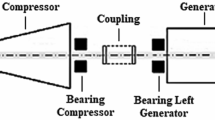Abstract
Predictive maintenance has been recognized by companies as a promising approach for reducing machine operation costs. It could be done in online and offline mode. In any case, the key issue is how to process acquired data, how to interpret diagnostic features, and how robust the final decision is. Unfortunately, in case of mining machines, classical diagnostic techniques used commonly in various applications often fail in the sense of false alarms, lack of detection, etc. The problem has been first recognized as an influence of time-varying load/speed conditions. Recent research done for mining machines showed that one might obtain misleading results due to contamination by non-Gaussian and impulsive noise as well. Source of such non-Gaussian noise could be related to process (mechanical excavation, crushing, milling, etc.) or natural operation of the machine (compression, pumping), can be transmitted to the sensor from other machine operated nearby, and might have purely random, accidental nature, etc. In any case, one needs appropriate tools to process such noisy data. According to our experience, a good example to illustrate the problem and one of the most challenging machines is the copper ore crusher, where regime of work produces impulsive noise related to falling pieces of ore into crusher, as well as crushing process. Classical methods based on the detection of impulsivity will not provide satisfactory results. One needs to take into account cyclic nature of fault-related signal. For this class of diagnostic problems, we have developed a set of tools that is based on alpha-stable (heavy-tailed in general) distribution. Framework for localized damage detection in gears or bearings is as follows: we use time–frequency decomposition of the vibration signal to obtain set of sub-signals with simplest structure instead of one complex signal. Extracted time series from each of the frequency bands can be analyzed separately in the context of impulsive and cyclic nature. We have adopted advanced modeling techniques defined for signals with heavy-tailed distributions. We are able to identify so-called informative frequency band (to asses which sub-signals are informative) and identify cycle/period of disturbance by generalized measures of dependence for heavy-tailed signals (codifference, covariation, Fractional Lower Order Covariance—FLOC). Note that due to impulsive character of the signal, one cannot apply methods requiring finite variance (autocorrelation should not be used). Thus, authors proposed to apply appropriate counterparts for heavy-tailed data. In this paper, we will summarize the proposed approach and present the latest examples of applications to vibration data from mining machines.
Access this chapter
Tax calculation will be finalised at checkout
Purchases are for personal use only
Similar content being viewed by others
References
Antoni, J.: The infogram: entropic evidence of the signature of repetitive transients. Mech. Syst. Signal Process. 74, 73–94 (2016)
Rosadi, D.: Testing for independence in heavy-tailed time series using the codifference function. Comput. Stat. Data Anal. 53(12), 4516–4529 (2009)
Antoni, J.: Cyclostationarity by examples. Mech. Syst. Signal Process. 23(4), 987–1036 (2009)
Barszcz, T., Jabłoński, A.: A novel method for the optimal band selection for vibration signal demodulation and comparison with the kurtogram. Mech. Syst. Signal Process. 25(1), 431–451 (2011)
Kruczek, P., et al.: Cyclic sources extraction from complex multiple-component vibration signal via periodically time varying filter. Appl. Acoust. 126, 170–181 (2017)
Wodecki, J., Michalak, A., Zimroz, R.: Optimal filter design with progressive genetic algorithm for local damage detection in rolling bearings. Mech. Syst. Signal Process. 102, 102–116 (2018)
Żak, G., Wyłomańska, A., Zimroz, R.: Local damage detection method based on distribution distances applied to time-frequency map of vibration signal. IEEE Trans. Ind. Appl. (2018). https://doi.org/10.1109/tia.2018.2828787
Wyłomańska, A., Zimroz, R., Janczura, J., Obuchowski, J.: Impulsive noise cancellation method for copper ore crusher vibration signals enhancement. IEEE Trans. Industr. Electron. 63(9), 5612–5621 (2016)
Samorodnitsky, G., Taqqu, M.: Stable Non-Gaussian Random Processes. Chapman and Hall, New York (1994)
Ma, X., Nikias, C.L.: Joint estimation of time delay an frequency delay in impulsive noise using fractional lower order statistics. IEEE Trans. Sig. Process. 44(11), 2669–2687 (1996)
Allen, J.: Short term spectral analysis, synthesis, and modification by discrete fourier transform. IEEE Trans. Acoust. Speech Signal Process. 25(3), 235–238 (1977)
Obuchowski, J., Wyłomańska, A., Zimroz, R.: The local maxima method for enhancement of time-frequency map and its application to local damage detection in rotating machines. Mech. Syst. Signal Process. 46(2), 389–405 (2014)
Author information
Authors and Affiliations
Corresponding author
Editor information
Editors and Affiliations
Rights and permissions
Copyright information
© 2019 Springer Nature Switzerland AG
About this paper
Cite this paper
Żak, G., Wyłomańska, A., Zimroz, R. (2019). Predictive Maintenance of Mining Machines—Problem of Non-Gaussian Noise. In: Widzyk-Capehart, E., Hekmat, A., Singhal, R. (eds) Proceedings of the 27th International Symposium on Mine Planning and Equipment Selection - MPES 2018. Springer, Cham. https://doi.org/10.1007/978-3-319-99220-4_37
Download citation
DOI: https://doi.org/10.1007/978-3-319-99220-4_37
Published:
Publisher Name: Springer, Cham
Print ISBN: 978-3-319-99219-8
Online ISBN: 978-3-319-99220-4
eBook Packages: Earth and Environmental ScienceEarth and Environmental Science (R0)




